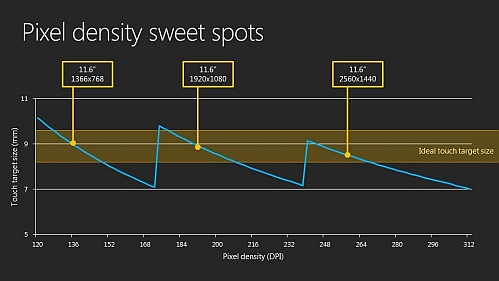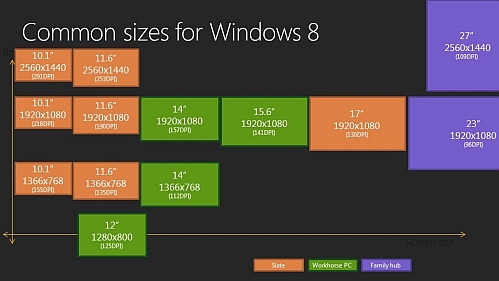
Microsoft's own Steven Sinofsky, President of the Windows Division, has stated that screen size, resolution, and pixel density were each considered carefully when designing Windows 8 for users and developers. "When talking about screens, it is very important to be clear about the variable or dimension being talked about," says Sinofsky. "For example, a 13” screen might be running at any number of resolutions (which means any number of pixel densities) and might have one of several different aspect ratios. But just because more content can fit on screen this doesn’t mean every app will make use of this space. If an app is designed with fixed dimensions or a specific form factor in mind, larger monitors may display a large empty region, as in the example below. This is not a good experience, as some have commented."
This is where "Post-HD" resolutions with pixel density reminiscent of Apple's Retina Displays come to mind. Microsoft has essentially analyzed the expected range of display sizes and resolutions for smartphones, tablets, notebooks, ultrabooks and desktops, and have identified a "sweet spot" zone for the three general classes of resolutions - Standard High Definition (1366x768), Full High Definition (1920x1080) and Quad XGA (2560x1440). The company ultimate anticipates a future in which tablets running Windows 8 ARM Edition will also feature resolutions higher than Full HD, similar to Apple's third-generation iPad (2048x1536), and has adopted solutions that will cater to such a wide diversity of pixel ranges - including new scaling methods for text and support for SVG as a standard development asset.
Published in
News
Windows 8 on tablets, desktops will support Retina Display resolutions

The "Post-HD" era begins in 2013
Forget about all the incessantly convoluted talk of conventional computing being replaced by a more sophisticated "Post-PC" era demarked by tablets, smartphones and Smart TVs which all utilize the "computer-like" architectures and apparently have no say in popular media anymore as "being anymore of a PC" than, well, a PC. According to a recent post on Microsoft's Building Windows 8 blog, the company is preparing to support a wide variety of highly pixel-dense resolutions on its forthcoming Windows 8 operating system.



